Trends in Meat Production – 2018
In this piece we will examine trends in the production of farmed animals. These trends can reveal which countries and species need the most focus, and can also help determine which species or countries may currently be overlooked. These trends can also be used in the future to help determine progress of the animal advocacy movement. This write up focuses on farmed land vertebrates, because they are the animals for whom data is most readily available.
Table of Contents
FAO Data
The United Nations Food and Agriculture Organization (FAO) compiles yearly statistics on livestock production and population. Information is provided on both the number of animals slaughtered and the tons of meat produced. Unsurprisingly, countries with large populations dominate the lists, but there are a number of trends that can be observed.
Number of animals slaughtered
We first look in terms of the number of animals being slaughtered, broken down by species, in the most recent year available (2016). For almost all species, China tops the lists—usually by a large margin. The United States is often high on lists, but there are many exceptions (such as for ducks, rabbits, and geese).
It is also notable how few European countries appear on these lists. In particular, no European countries are among the top ten countries in chicken slaughtering. The European countries producing large amounts of meat can best be seen when we turn to look at the total tons of meat produced in each country. These tables suggest that there is a great need for animal advocacy in non-European countries.
| Country | Totals slaughtered | Totals slaughtered per capita |
|---|---|---|
| World | 74,171,872,986 | 9.93 |
| China, mainland | 13,714,304,809 | 9.77 |
| United States of America | 9,331,441,493 | 28.96 |
| European Union | 8,351,146,351 | 16.43 |
| Brazil | 6,261,689,332 | 30.15 |
| Indonesia | 2,781,838,037 | 10.65 |
| India | 2,603,793,812 | 1.97 |
| Russian Federation | 2,499,046,703 | 17.36 |
| Iran (Islamic Republic of) | 1,876,830,955 | 23.38 |
| Mexico | 1,723,321,241 | 13.51 |
| Myanmar | 1,537,161,690 | 29.07 |
| Thailand | 1,241,852,065 | 18.03 |
| Country | Chickens slaughtered | Chickens slaughtered per capita |
|---|---|---|
| World | 65,847,411,000 | 8.82 |
| China, mainland | 9,225,812,000 | 6.57 |
| United States of America | 8,909,014,000 | 27.65 |
| European Union | 7,418,459,000 | 14.60 |
| Brazil | 6,078,968,000 | 29.27 |
| Indonesia | 2,713,234,000 | 10.39 |
| India | 2,483,019,000 | 1.88 |
| Russian Federation | 2,432,698,000 | 16.90 |
| Iran (Islamic Republic of) | 1,851,879,000 | 23.07 |
| Mexico | 1,676,866,000 | 13.15 |
| Myanmar | 1,393,579,000 | 26.35 |
| Thailand | 1,199,528,000 | 17.42 |
| Country | Ducks slaughtered | Ducks slaughtered per capita |
|---|---|---|
| World | 3,056,103,000 | 0.41 |
| China, mainland | 2,243,872,000 | 1.60 |
| European Union | 171,960,000 | 0.34 |
| Myanmar | 118,408,000 | 2.24 |
| Vietnam | 106,067,000 | 1.12 |
| France | 69,917,000 | 1.08 |
| Bangladesh | 52,116,000 | 0.32 |
| Malaysia | 51,009,000 | 1.64 |
| Indonesia | 40,126,000 | 0.15 |
| China, Taiwan Province of | 36,184,000 | 1.54 |
| Egypt | 31,416,000 | 0.33 |
| Hungary | 28,867,000 | 2.96 |
| Country | Pigs slaughtered | Pigs slaughtered per capita |
|---|---|---|
| World | 1,478,167,073 | 0.20 |
| China, mainland | 705,756,377 | 0.50 |
| European Union | 260,012,426 | 0.51 |
| United States of America | 118,303,900 | 0.37 |
| Germany | 59,480,468 | 0.73 |
| Vietnam | 51,115,510 | 0.54 |
| Spain | 47,258,610 | 1.02 |
| Brazil | 39,805,749 | 0.19 |
| Russian Federation | 38,603,959 | 0.27 |
| Philippines | 26,628,771 | 0.26 |
| France | 24,138,654 | 0.37 |
| Poland | 22,098,424 | 0.58 |
| Country | Rabbits slaughtered | Rabbits slaughtered per capita |
|---|---|---|
| World | 980,785,000 | 0.13 |
| China, mainland | 562,739,000 | 0.40 |
| European Union | 167,589,000 | 0.33 |
| Democratic People’s Republic of Korea | 132,830,000 | 5.24 |
| Egypt | 58,520,000 | 0.61 |
| Spain | 47,357,000 | 1.02 |
| France | 33,247,000 | 0.51 |
| Italy | 26,916,000 | 0.45 |
| Germany | 22,652,000 | 0.28 |
| Czechia | 20,575,000 | 1.94 |
| Algeria | 8,345,000 | 0.21 |
| Sierra Leone | 8,118,000 | 1.10 |
| Country | Turkeys slaughtered | Turkeys slaughtered per capita |
|---|---|---|
| World | 673,278,000 | 0.09 |
| United States of America | 243,255,000 | 0.76 |
| European Union | 226,867,000 | 0.45 |
| Brazil | 90,551,000 | 0.44 |
| France | 52,245,000 | 0.81 |
| Poland | 37,482,000 | 0.98 |
| Germany | 37,366,000 | 0.46 |
| Italy | 30,944,000 | 0.52 |
| Spain | 21,482,000 | 0.46 |
| Canada | 21,231,000 | 0.59 |
| United Kingdom | 15,400,000 | 0.23 |
| Morocco | 14,323,000 | 0.41 |
| Country | Geese and guinea fowl slaughtered | Geese and guinea fowl slaughtered per capita |
|---|---|---|
| World | 658,903,000 | 0.09 |
| China, mainland | 611,779,000 | 0.44 |
| European Union | 14,632,000 | 0.03 |
| Egypt | 9,980,000 | 0.10 |
| Poland | 7,102,000 | 0.19 |
| Myanmar | 5,082,000 | 0.10 |
| Hungary | 5,061,000 | 0.52 |
| China, Taiwan Province of | 4,500,000 | 0.19 |
| Ukraine | 4,284,000 | 0.10 |
| Madagascar | 4,232,000 | 0.17 |
| Iran (Islamic Republic of) | 1,044,000 | 0.01 |
| Israel | 994,000 | 0.12 |
| Country | Sheep slaughtered | Sheep slaughtered per capita |
|---|---|---|
| World | 551,420,651 | 0.07 |
| China, mainland | 144,027,014 | 0.10 |
| European Union | 52,278,200 | 0.10 |
| Australia | 29,788,600 | 1.23 |
| New Zealand | 24,776,360 | 5.32 |
| Turkey | 22,025,280 | 0.28 |
| India | 19,529,269 | 0.01 |
| Nigeria | 17,141,531 | 0.09 |
| Algeria | 16,063,931 | 0.40 |
| Sudan | 15,513,159 | 0.39 |
| United Kingdom | 14,556,000 | 0.22 |
| Pakistan | 11,264,000 | 0.06 |
| Country | Goats slaughtered | Goats slaughtered per capita |
|---|---|---|
| World | 459,861,000 | 0.06 |
| China, mainland | 163,167,869 | 0.12 |
| India | 50,519,315 | 0.04 |
| Bangladesh | 29,812,862 | 0.18 |
| Nigeria | 25,167,866 | 0.14 |
| Pakistan | 17,667,177 | 0.09 |
| Sudan | 12,445,013 | 0.31 |
| Iran (Islamic Republic of) | 10,343,166 | 0.13 |
| Indonesia | 7,402,290 | 0.03 |
| Mali | 6,813,294 | 0.38 |
| South Sudan | 6,789,002 | 0.56 |
| Yemen | 6,462,449 | 0.23 |
| Country | Cows slaughtered | Cows slaughtered per capita |
|---|---|---|
| World | 302,018,862 | 0.04 |
| China, mainland | 49,184,749 | 0.04 |
| Brazil | 37,595,000 | 0.18 |
| United States of America | 31,188,800 | 0.10 |
| European Union | 27,159,481 | 0.05 |
| Argentina | 11,720,350 | 0.27 |
| India | 8,825,483 | 0.01 |
| Australia | 8,796,400 | 0.36 |
| Russian Federation | 8,100,928 | 0.06 |
| Mexico | 7,957,971 | 0.06 |
| Uzbekistan | 5,189,349 | 0.17 |
| New Zealand | 4,763,321 | 1.02 |
Tons of meat
The UN FAO data also provides information on the total tons of meat produced across all species. Here we see that while European countries are generally not very high in terms of the number of animals killed for meat production, they are high in terms of tons of meat produced. This can be explained by the differences in species produced, with European countries generally raising larger species of animals.
Among western European countries, the top producers of meat (in tons, not in the number of animals slaughtered) are Germany, Spain, and France. In particular, Germany is the third largest producer of pig meat and turkey meat, and France is the second largest producer of duck meat. These trends suggest a possible direction for species-specific advocacy.
| Country | Total meat (tons) | Total meat (kilograms per capita) |
|---|---|---|
| World | 329,890,425 | 44.18 |
| China, mainland | 85,987,175 | 61.27 |
| European Union | 47,471,558 | 93.41 |
| United States of America | 44,623,827 | 138.51 |
| Brazil | 27,440,984 | 132.15 |
| Russian Federation | 9,899,183 | 68.76 |
| Germany | 8,425,255 | 102.85 |
| India | 7,191,588 | 5.43 |
| Mexico | 6,553,805 | 51.39 |
| Spain | 6,196,330 | 133.69 |
| France | 5,655,531 | 87.38 |
| Argentina | 5,219,781 | 119.04 |
| Country | Chicken meat (tons) | Chicken meat (kilograms per capita) |
|---|---|---|
| World | 107,143,008 | 14.35 |
| United States of America | 18,708,326 | 58.07 |
| Brazil | 13,894,450 | 66.91 |
| China, mainland | 12,721,408 | 9.06 |
| European Union | 11,924,789 | 23.47 |
| Russian Federation | 4,141,365 | 28.77 |
| India | 3,398,812 | 2.57 |
| Mexico | 3,077,874 | 24.13 |
| Japan | 2,345,193 | 18.36 |
| Iran (Islamic Republic of) | 2,126,286 | 26.49 |
| Indonesia | 2,110,861 | 8.08 |
| Poland | 1,994,697 | 52.18 |
| Country | Duck meat (tons) | Duck meat (kilograms per capita) |
|---|---|---|
| World | 4,534,578 | 0.61 |
| China, mainland | 2,965,312 | 2.11 |
| European Union | 492,986 | 0.97 |
| France | 238,900 | 3.69 |
| Malaysia | 150,426 | 4.82 |
| Myanmar | 133,514 | 2.52 |
| Vietnam | 127,280 | 1.35 |
| Republic of Korea | 82,830 | 1.63 |
| Hungary | 78,769 | 8.08 |
| Egypt | 76,772 | 0.80 |
| China, Taiwan Province of | 66,967 | 2.84 |
| United States of America | 61,307 | 0.19 |
| Country | Pig meat (tons) | Pig meat (kilograms per capita) |
|---|---|---|
| World | 118,168,709 | 15.83 |
| China, mainland | 54,129,762 | 38.57 |
| European Union | 23,618,044 | 46.47 |
| United States of America | 11,320,182 | 35.14 |
| Germany | 5,589,639 | 68.24 |
| Spain | 3,947,015 | 85.16 |
| Vietnam | 3,664,556 | 38.75 |
| Brazil | 3,514,098 | 16.92 |
| Russian Federation | 3,368,235 | 23.40 |
| France | 2,185,430 | 33.77 |
| Canada | 2,047,946 | 56.43 |
| Poland | 2,008,800 | 52.55 |
| Country | Rabbit meat (tons) | Rabbit meat (kilograms per capita) |
|---|---|---|
| World | 1,428,085 | 0.19 |
| China, mainland | 849,150 | 0.61 |
| European Union | 257,001 | 0.51 |
| Democratic People’s Republic of Korea | 172,680 | 6.81 |
| Egypt | 65,602 | 0.69 |
| Italy | 54,347 | 0.91 |
| Spain | 50,552 | 1.09 |
| France | 48,396 | 0.75 |
| Czechia | 39,692 | 3.74 |
| Germany | 35,971 | 0.44 |
| Russian Federation | 18,189 | 0.13 |
| Ukraine | 12,200 | 0.27 |
| Country | Turkey meat (tons) | Turkey meat (kilograms per capita) |
|---|---|---|
| World | 6,060,883 | 0.81 |
| United States of America | 2,712,976 | 8.42 |
| European Union | 2,024,512 | 3.98 |
| Brazil | 596,302 | 2.87 |
| Germany | 487,100 | 5.95 |
| France | 393,287 | 6.08 |
| Italy | 331,859 | 5.58 |
| Spain | 192,629 | 4.16 |
| Poland | 178,537 | 4.67 |
| Canada | 168,547 | 4.64 |
| United Kingdom | 164,000 | 2.49 |
| Chile | 112,768 | 6.30 |
| Country | Goose and guinea fowl meat (tons) | Goose and guinea fowl meat (kilograms per capita) |
|---|---|---|
| World | 2,542,632 | 0.34 |
| China, mainland | 2,393,635 | 1.71 |
| European Union | 70,607 | 0.14 |
| Poland | 30,996 | 0.81 |
| Egypt | 26,894 | 0.28 |
| Hungary | 25,856 | 2.65 |
| China, Taiwan Province of | 18,134 | 0.77 |
| Madagascar | 12,696 | 0.51 |
| Myanmar | 8,380 | 0.16 |
| Germany | 5,100 | 0.06 |
| Israel | 3,308 | 0.40 |
| United Kingdom | 2,883 | 0.04 |
| Country | Sheep meat (tons) | Sheep meat (kilograms per capita) |
|---|---|---|
| World | 9,310,532 | 1.25 |
| China, mainland | 2,349,982 | 1.67 |
| European Union | 813,506 | 1.60 |
| Australia | 678,812 | 28.14 |
| New Zealand | 480,607 | 103.12 |
| Turkey | 353,942 | 4.45 |
| Iran (Islamic Republic of) | 310,676 | 3.87 |
| United Kingdom | 290,000 | 4.41 |
| Algeria | 271,388 | 6.68 |
| Sudan | 254,286 | 6.42 |
| India | 234,386 | 0.18 |
| Russian Federation | 194,510 | 1.35 |
| Country | Goat meat (tons) | Goat meat (kilograms per capita) |
|---|---|---|
| World | 5,621,333 | 0.75 |
| China, mainland | 2,264,966 | 1.61 |
| India | 505,371 | 0.38 |
| Pakistan | 301,589 | 1.56 |
| Nigeria | 243,230 | 1.31 |
| Bangladesh | 208,719 | 1.28 |
| Sudan | 111,532 | 2.82 |
| Mali | 95,415 | 5.30 |
| Iran (Islamic Republic of) | 82,958 | 1.03 |
| Myanmar | 79,418 | 1.50 |
| Mongolia | 76,903 | 25.40 |
| Turkey | 69,668 | 0.88 |
| Country | Cow meat (tons) | Cow meat (kilograms per capita) |
|---|---|---|
| World | 65,973,820 | 8.84 |
| United States of America | 11,470,489 | 35.60 |
| Brazil | 9,284,000 | 44.71 |
| European Union | 7,878,784 | 15.50 |
| China, mainland | 6,997,279 | 4.99 |
| Argentina | 2,644,000 | 60.30 |
| Australia | 2,360,756 | 97.85 |
| Mexico | 1,878,705 | 14.73 |
| Russian Federation | 1,618,972 | 11.25 |
| France | 1,458,284 | 22.53 |
| Germany | 1,155,483 | 14.11 |
| Canada | 1,132,879 | 31.22 |
Total stock
The FAO also provides information on the total stock of animals in each country, broken down by species. This gives a snapshot of the total number of animals involved in agriculture at a given moment. Because of the variation in age at which animals are slaughtered, we see that the cows form a much greater proportion of animals involved in animal agriculture at a given time than they do of animals slaughtered per year. Other longer-lived species such as sheep and goats follow a similar pattern. However, a majority of the farmed land animals in the analysis are still small animals, particularly chickens.
The countries with the largest populations of farmed animals are generally also those that slaughter many such animals. Some differences can be seen, with animals in countries with highly industrialized farming systems, such as the U.S. and much of Europe, generally seeming to live shorter lives than those in countries where animal farming is less industrialized.
| Country | Stock, All Species | Stock per capita, All species |
|---|---|---|
| World | 30,148,764,815 | 4.04 |
| China, mainland | 7,298,726,300 | 5.20 |
| United States of America | 2,405,244,146 | 7.47 |
| Indonesia | 2,164,461,633 | 8.29 |
| European Union | 1,940,900,910 | 3.82 |
| Brazil | 1,683,721,479 | 8.11 |
| India | 1,300,953,378 | 0.98 |
| Iran (Islamic Republic of) | 1,099,772,595 | 13.70 |
| Pakistan | 695,866,933 | 3.60 |
| Mexico | 643,658,938 | 5.05 |
| Russian Federation | 610,019,370 | 4.24 |
| Bangladesh | 404,146,441 | 2.48 |
| Country | Chickens | Chickens per capita |
|---|---|---|
| World | 22,705,417,000 | 3.04 |
| China, mainland | 5,062,592,000 | 3.61 |
| Indonesia | 2,053,397,000 | 7.86 |
| United States of America | 1,971,947,000 | 6.12 |
| European Union | 1,411,155,000 | 2.78 |
| Brazil | 1,352,291,000 | 6.51 |
| Iran (Islamic Republic of) | 1,025,815,000 | 12.78 |
| India | 774,250,000 | 0.58 |
| Mexico | 549,125,000 | 4.31 |
| Pakistan | 505,902,000 | 2.62 |
| Russian Federation | 490,418,000 | 3.41 |
| Turkey | 329,011,000 | 4.14 |
| Country | Cows | Cows per capita |
|---|---|---|
| World | 1,474,887,717 | 0.20 |
| Brazil | 218,225,177 | 1.05 |
| India | 185,987,136 | 0.14 |
| United States of America | 91,918,000 | 0.29 |
| European Union | 90,057,258 | 0.18 |
| China, mainland | 84,374,700 | 0.06 |
| Ethiopia | 59,486,667 | 0.58 |
| Argentina | 52,636,778 | 1.20 |
| Pakistan | 42,800,000 | 0.22 |
| Mexico | 33,918,906 | 0.27 |
| Sudan | 30,559,650 | 0.77 |
| United Republic of Tanzania | 27,015,712 | 0.49 |
| Country | Ducks | Ducks per capita |
|---|---|---|
| World | 1,241,388,000 | 0.17 |
| China, mainland | 810,503,000 | 0.58 |
| Vietnam | 71,286,000 | 0.75 |
| Bangladesh | 52,240,000 | 0.32 |
| Indonesia | 47,360,000 | 0.18 |
| European Union | 44,481,000 | 0.09 |
| Russian Federation | 30,896,000 | 0.21 |
| France | 24,534,000 | 0.38 |
| Myanmar | 23,627,000 | 0.45 |
| India | 21,019,000 | 0.02 |
| Thailand | 13,711,000 | 0.20 |
| Malaysia | 10,656,000 | 0.34 |
| Country | Sheep | Sheep per capita |
|---|---|---|
| World | 1,173,353,790 | 0.16 |
| China, mainland | 162,062,500 | 0.12 |
| European Union | 98,317,716 | 0.19 |
| Australia | 67,543,092 | 2.80 |
| India | 63,016,181 | 0.05 |
| Iran (Islamic Republic of) | 42,501,987 | 0.53 |
| Nigeria | 42,091,042 | 0.23 |
| Sudan | 40,552,860 | 1.02 |
| United Kingdom | 33,943,000 | 0.52 |
| Turkey | 31,507,934 | 0.40 |
| Ethiopia | 30,697,942 | 0.30 |
| Pakistan | 29,800,000 | 0.15 |
| Country | Pigs | Pigs per capita |
|---|---|---|
| World | 981,797,339 | 0.13 |
| China, mainland | 451,125,000 | 0.32 |
| European Union | 148,854,114 | 0.29 |
| United States of America | 71,500,400 | 0.22 |
| Brazil | 39,950,320 | 0.19 |
| Spain | 29,231,595 | 0.63 |
| Vietnam | 29,075,315 | 0.31 |
| Germany | 27,376,056 | 0.33 |
| Russian Federation | 21,506,497 | 0.15 |
| Mexico | 16,753,231 | 0.13 |
| Myanmar | 16,524,336 | 0.31 |
| Canada | 12,770,461 | 0.35 |
| Country | Goats | Goats per capita |
|---|---|---|
| World | 1,002,810,368 | 0.13 |
| China, mainland | 148,934,400 | 0.11 |
| India | 133,874,637 | 0.10 |
| Nigeria | 73,879,561 | 0.40 |
| Pakistan | 70,300,000 | 0.36 |
| Bangladesh | 56,083,240 | 0.34 |
| Sudan | 31,325,105 | 0.79 |
| Ethiopia | 30,200,226 | 0.29 |
| Kenya | 26,745,916 | 0.55 |
| Mongolia | 25,574,861 | 8.45 |
| Mali | 22,141,497 | 1.23 |
| Indonesia | 19,608,181 | 0.08 |
| Country | Turkeys | Turkeys per capita |
|---|---|---|
| World | 468,745,000 | 0.06 |
| United States of America | 244,000,000 | 0.76 |
| European Union | 91,533,000 | 0.18 |
| Chile | 34,973,000 | 1.95 |
| Brazil | 32,501,000 | 0.16 |
| Italy | 25,141,000 | 0.42 |
| France | 20,582,000 | 0.32 |
| Germany | 13,352,000 | 0.16 |
| Morocco | 12,341,000 | 0.35 |
| Poland | 11,706,000 | 0.31 |
| Tunisia | 11,496,000 | 1.01 |
| Portugal | 6,436,000 | 0.62 |
| Country | Geese and guinea fowl | Geese and guinea fowl per capita |
|---|---|---|
| World | 380,620,000 | 0.05 |
| China, mainland | 315,350,000 | 0.22 |
| Russian Federation | 15,448,000 | 0.11 |
| Mozambique | 12,291,000 | 0.43 |
| European Union | 10,975,000 | 0.02 |
| Egypt | 7,045,000 | 0.07 |
| Ukraine | 5,115,000 | 0.12 |
| Romania | 4,688,000 | 0.24 |
| Poland | 3,989,000 | 0.10 |
| Myanmar | 3,455,000 | 0.07 |
| Madagascar | 3,014,000 | 0.12 |
| China, Taiwan Province of | 2,394,000 | 0.10 |
| Country | Rabbits and hares | Rabbits and hares per capita |
|---|---|---|
| World | 316,686,000 | 0.04 |
| China, mainland | 226,202,000 | 0.16 |
| Democratic People’s Republic of Korea | 35,946,000 | 1.42 |
| European Union | 23,396,000 | 0.05 |
| Czechia | 6,049,000 | 0.57 |
| Italy | 5,766,000 | 0.10 |
| Ukraine | 5,043,000 | 0.11 |
| Nigeria | 4,647,000 | 0.02 |
| Russian Federation | 3,721,000 | 0.03 |
| Egypt | 3,638,000 | 0.04 |
| Spain | 3,569,000 | 0.08 |
| Romania | 1,826,000 | 0.09 |
USDA Data
From the tables above, we see that the United States is one of the key countries in meat production. For this reason, we will look further into trends over time in the production of farmed animals in the United States. In order to understand these trends, the primary two metrics we consider are the number of animals killed per capita and the pounds of meat produced per capita. We look at the numbers on a per capita basis in order to control for effect of population growth and make other trends more apparent. In the United States, monthly data on meat production from vertebrate land animals is provided by the United States Department of Agriculture (USDA). Monthly population data is provided by the Federal Bank of St. Louis. To get a sense of the overall trends we first look at the total number of animals slaughtered per capita and the total pounds of meat produced per capita.
In the plots below, each dot represents the value in a given month. Fit lines are given using local regression, a generalization of linear regression which is useful for data exhibiting non-linear trends. Data is available for birds going back to 1960 and mammals going back to 1983, but we display only the data from 2000 to the present because we are most interested in tracking the progress of the present-day animal advocacy movement. The R code used to generate these plots is available upon request.
Number of animals slaughtered
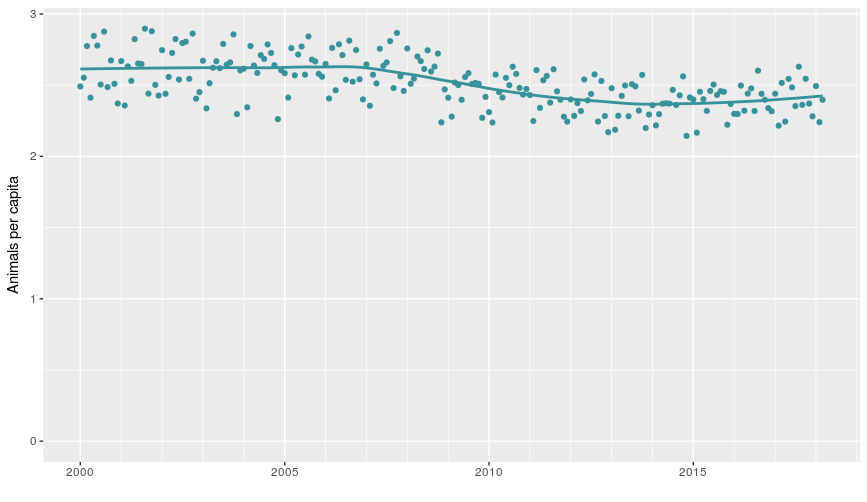
In Figure 1 we see an overall downward trend in the number of animals slaughtered per capita, particularly around the years 2008 and 2009. While the number of animals slaughtered per capita has decreased in this time frame, it must be stressed that because the United States population has increased, this does not mean that the total number of animals slaughtered has decreased. The average number of animals slaughtered per capita each month was 2.51.
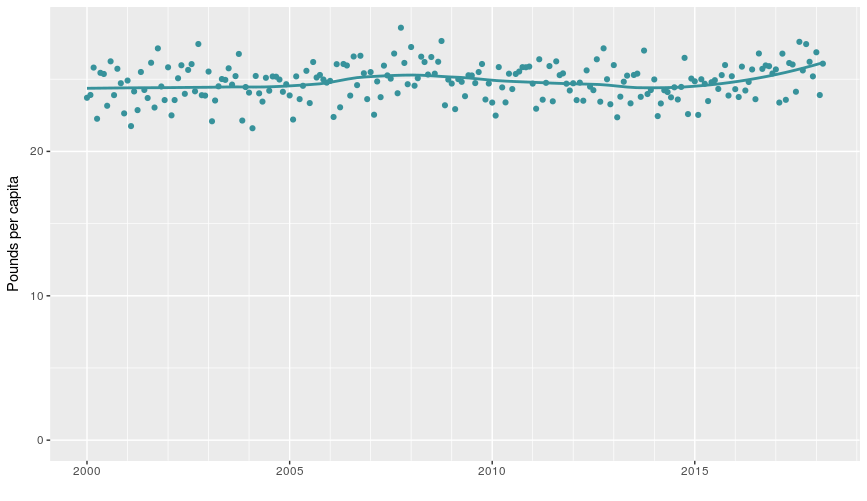
The overall trend in Figure 2 shows that the pounds per capita of meat produced has remained relatively constant between 2000 and 2018. Over this time period, the average was 24.8 pounds of meat produced per capita each month.
In both Figure 1 and Figure 2 a notable feature is the downturn in production around the years 2008 and 2009. This downturn is especially pronounced in Figure 1, where the most recent numbers show that the total number of animals slaughtered per capita is still below its peak between 2000 and 2005. While Figure 1 shows an overall decrease in one measure of production, Figure 2 shows an overall increase. The reason for the differences between these plots is change in the relative numbers of different species being produced and changes in the average weights of those species. When heavier animals are killed, meat production in pounds per capita can increase while the number of animals slaughtered per capita can decrease.
To get a better sense of the trends, we look at a breakdown by species. By far the majority of land animals slaughtered are chickens, so the plot of chickens slaughtered per capita looks similar to the plot of all animals slaughtered per capita.
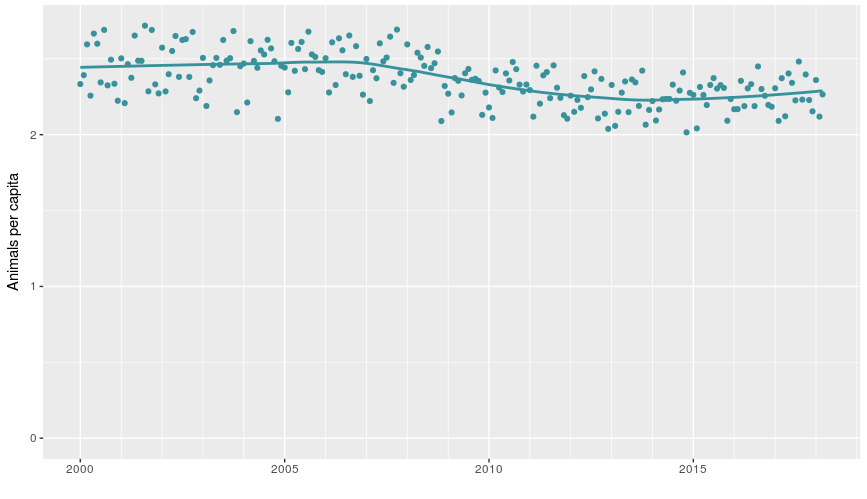
In Figure 3 we see generally the same trend as in Figure 1. The average number of chickens slaughtered per capita in this time period was 2.36 per month, which makes up the bulk of the total 2.51 animals slaughtered per capita per month seen in Figure 1.
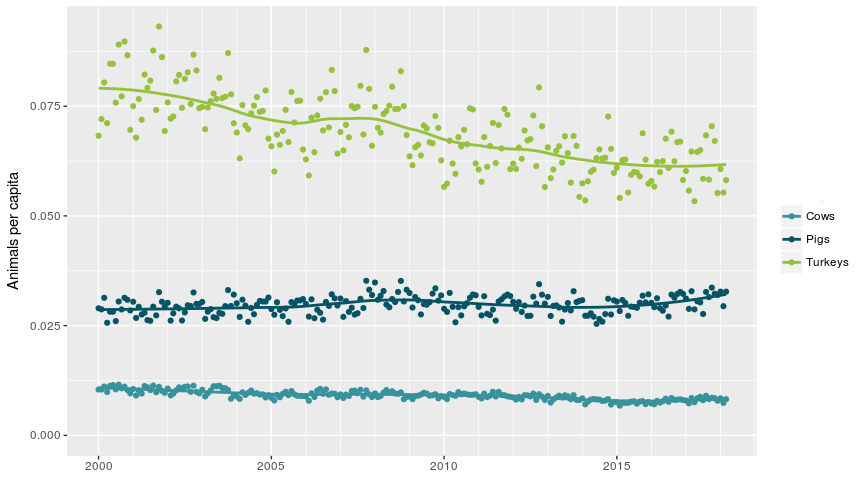
For turkeys, the trend in Figure 4 is an overall decrease, and the average over the time period shown is 0.0691 turkeys slaughtered per capita per month (or 0.829 per year).
We see in Figure 4 that while there has been some variation in the slaughter of pigs—with a peak around 2008—the number slaughtered per capita has, overall, increased beyond its level in 2000. We also note that the average number of pigs slaughtered per capita from 2000 to 2018 was 0.0297 per month (or 0.356 per year).
The trend for cows has been an overall decrease in the number slaughtered per capita from 2000 to 2018, with an average of 0.00911 per month (or 0.109 per year). However, it should be noted that total number of cows slaughtered appears to be rising since the minimum in 2015.
Pounds of meat
While the number of animals being slaughtered is an important metric in that it directly shows the number of animals affected by meat production, the total pounds of meat produced gives us a better view of consumer choices. While the number of animals slaughtered varies greatly from species to species, the pounds of meat produced doesn’t vary as much across species, so we can more easily make comparisons between species and see some shifts in the types of meat being produced.
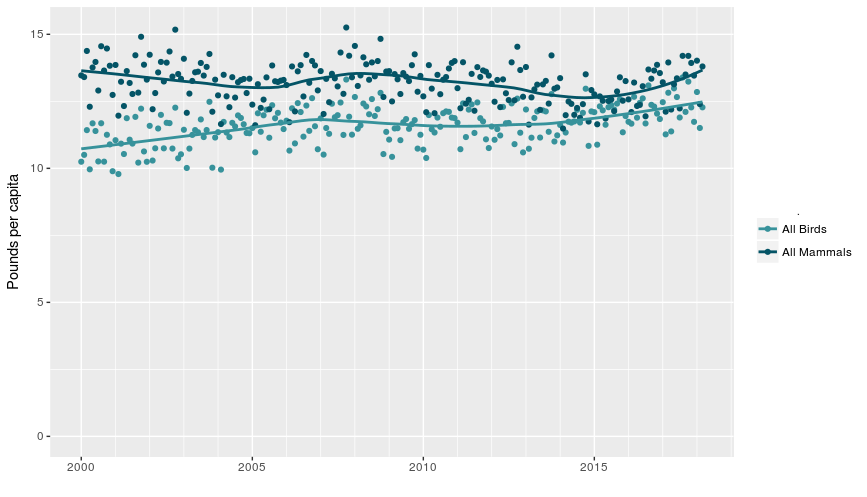
We see from Figure 5 that the total amount of mammal meat (“red meat”) being produced and the total amount of bird meat (“poultry”) being produced are nearer than they have been in the past. Over this time period, the total amount of mammal meat produced per capita per month was 13.2 pounds, while for bird meat it was 11.6 pounds.

Figure 6 provides further detail for the trends seen in Figure 5. Namely, the decrease in mammal meat production per capita is primarily due to a decrease in the amount of cow meat produced per capita, whereas pig meat production per capita has increased over this time. In this time period, the per capita meat production for chickens has averaged 9.86 pounds per month. For cows it has averaged 7.05 pounds per month, and for pigs it has averaged 6.04 pounds per month.
While the total number of chickens slaughtered per capita is below its level in 2000, Figure 6 shows that the total pounds of chicken meat produced per capita has increased beyond its level in 2000.
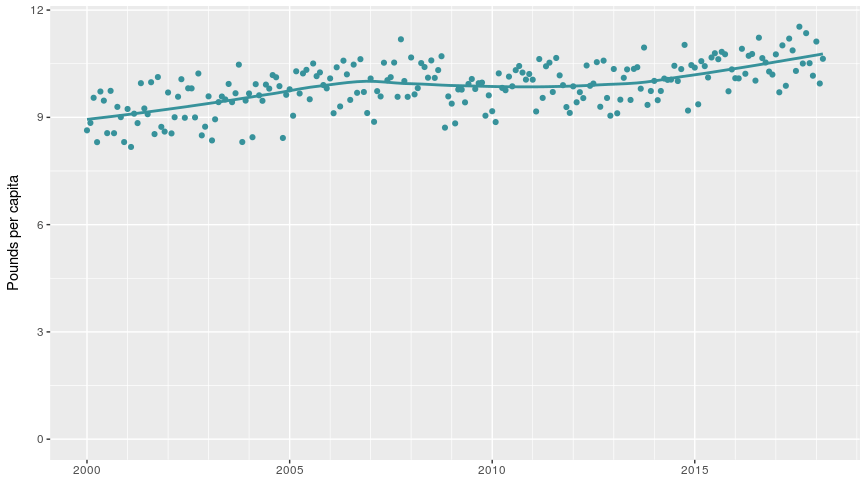
The explanation for this is that the average weight of chickens has increased somewhat linearly over this time period.
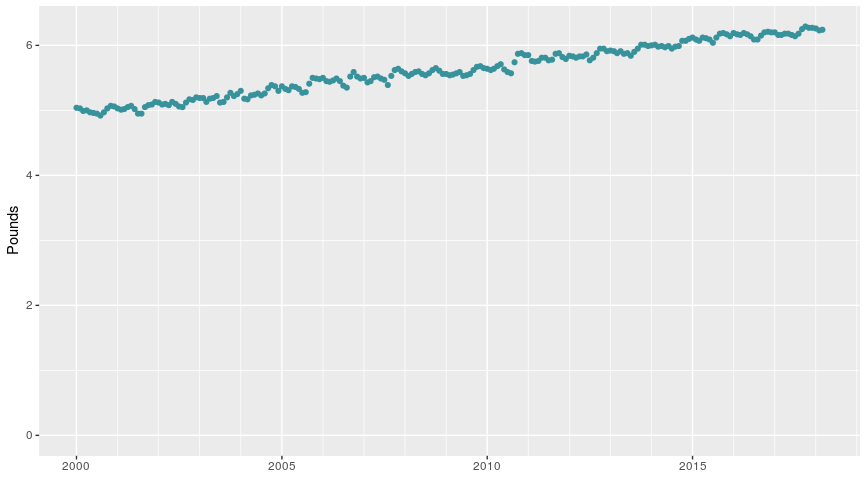
Figure 8 shows that the average weight of chickens has increased from about 5 pounds at slaughter in 2000 to 6.3 pounds in 2018.

In Figure 9 we see a similar trend in turkeys, increasing in weight from around 26 pounds in 2000 to around 31 pounds in 2018. In turkeys, the average weight at slaughter appears to exhibit more seasonal variation than the average chicken weight seen in Figure 10.

We also see an increasing trend in the average weight of pigs at slaughter in Figure 10, from around 260 pounds in 2000 to around 285 pounds in 2018. While the overall trend for average pig weight in this time period is increasing, there are, again, seasonal variations.

In Figure 11 we see that average cow weight at slaughter has increased from about 1,225 pounds in 2000 to around 1,360 pounds in 2018. Again, there appear to be seasonal variations.
Conclusion
From the FAO data we see that the main countries producing meat (in terms of animals slaughtered, weight of meat produced, and total stock) are China, the United States, Brazil, and Indonesia. We also see that, relative to other countries, European countries tend to favor the production of larger animals. While these animals also tend to be longer-lived and therefore account for a greater proportion of the total stock than of animals slaughtered, European countries are still not among the highest producers by that metric. We also see that some of the species most affected by animal agriculture are ducks, rabbits, geese, and guinea fowl, which are not commonly among animals represented in animal advocacy. This reflects the movement’s focus on the western hemisphere.
In the United States, the number of animals slaughtered per capita has decreased since 2000, while the weight of meat produced per capita has increased. This appears to be due to the increasing weight of the animals being slaughtered. While the pounds of meat per capita have overall increased since 2000, there are time periods during which it decreased.
Further Questions
Further research should work towards ascertaining the extent to which these trends can be explained by economic factors such as meat price and gross domestic product (GDP) per capita. A better understanding of this relationship will help determine to what extent meat production is influenced by other factors, among them animal advocacy. In addition, understanding the effect of meat prices on meat production will help advocates determine the value of advocacy efforts that affect those prices.
Another avenue of further research is to explore similar trends in the production of invertebrates and fish.
Finally, exploring trends over time in other countries—particularly China—could prove quite valuable, especially as the animal advocacy movement begins to devote more resources towards China. In addition, we would be interested in exploring trends in total stock over time in the U.S., although we were not able to find the relevant data at this time.
Livestock Production. (2018). The Food and Agriculture Organization Corporate Statistical Database (FAOSTAT).
Livestock & Meat Domestic Data. (2018). United States Department of Agriculture Economic Research Service.